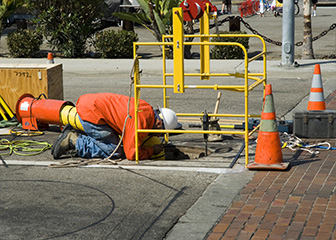How to Become an Occupational Health and Safety Technician About this section

Technicians carry out and evaluate programs on workplace safety and health.
Occupational health and safety technicians can enter the occupation through two main paths. The most common path is through on-the-job training. However, others enter with formal education, such as an associate degree or certificate. Technicians are trained in the specific laws or inspection procedures through a combination of classroom and on-the-job training.
Training
It is common for technicians to enter the occupation through a combination of related work experience and training. These technicians typically take on health and safety tasks at the company where they are employed at the time. For example, an employee may volunteer to complete annual workstation inspections for an office where they already work. They usually receive on-the-job training along with some formal education on how to conduct the correct tests or recognize common problems.
Education
High school students interested in the occupation should complete courses in English, mathematics, chemistry, biology, and physics.
Some technicians attend community college or vocational school and earn an associate’s degree or certificate. These programs typically include courses in respiratory protection, hazard communication, and material handling and storage procedures. Some or all courses may be taken online, depending on the program.
Occupational health and safety technicians may train in more than one area of interest. Although technicians with formal education learn standard laws and procedures while in school, a moderate amount of on-the-job training is required for specific work environments.
Occupational health and safety technicians can become specialists by earning a bachelor’s or advanced degree.
Certification
Certification is not required to become an occupational health and safety technician; however, many employers encourage it. The Board of Certified Safety Professionals (BCSP) offers certification at the technician level.
To apply for any certification, technicians must either have formal education in health and safety resulting in a degree or certificate, or at least 3 years of on-the-job experience in occupational health or safety. All applicants must pass a standardized health and safety exam.
There are three common certifications for technicians:
Construction Health and Safety Technician Certification (CHST) requires the applicant to have specific education or experience in construction safety. These technicians protect workers on construction sites from injury or illness.
Occupational Health and Safety Technologist Certification (OHST) certification is designed for workers who do occupational health and safety tasks full-time or part-time as part of their job duties.
Safety Trained Supervisor (STS) certification is geared toward first-line supervisors or managers. These workers are not safety practitioners but take on the certification in addition to their other job duties.
Important Qualities
Communication skills. Occupational health and safety technicians must be able to work with specialists to collect and test samples of possible hazards, such as dust or vapors, in the workplace.
Detail oriented. Occupational health and safety technicians must be able to understand and adhere to specific safety standards and government regulations.
Problem-solving skills. Occupational health and safety technicians must be able to use their skills to find solutions to unsafe working conditions and environmental concerns in the workplace.
Stamina. Occupational health and safety technicians must be able to stay on their feet for long periods of time and to travel on a regular basis.
Technical skills. Occupational health and safety technicians often work with computers and complex testing equipment.








